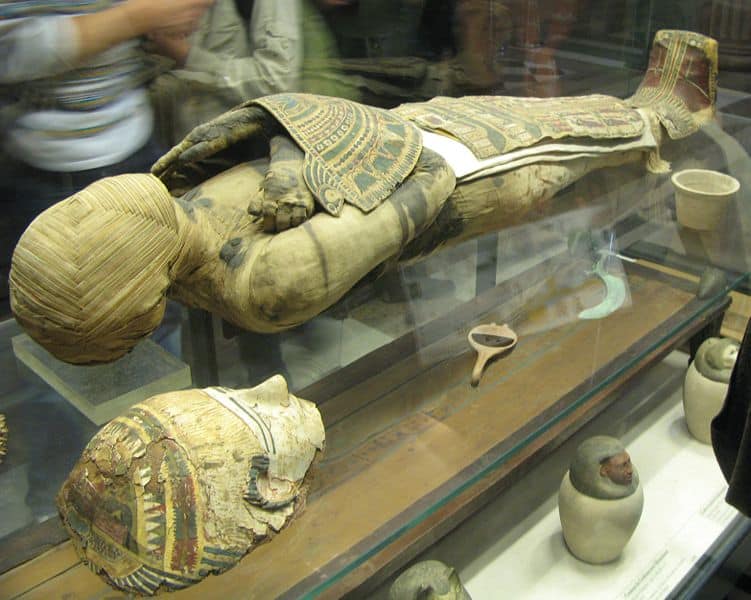When you start planning your visit to the Louvre, it can be pretty overwhelming.
This world-famous institution is home to fine art paintings, sculptures, archaeology, design, furniture, and iconic architecture.
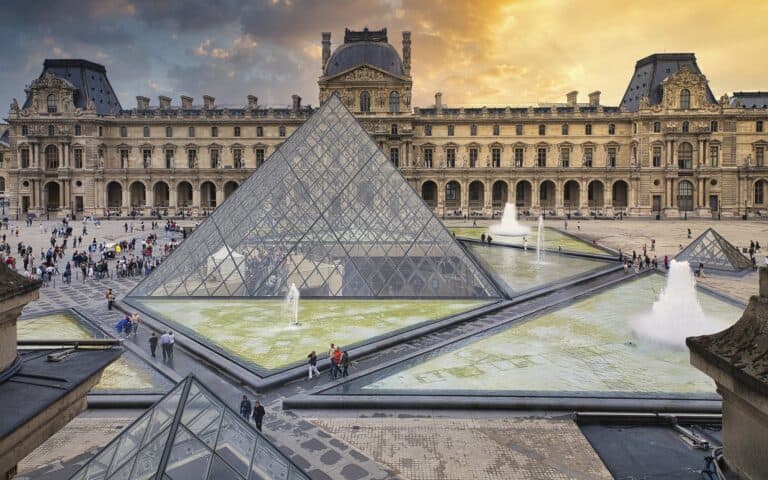
But while you’re sure to enjoy the Egyptian collection, Venus de Milo, and Winged Venus of Samothrace, the paintings are worth the admission fee alone.
Of course, we all know about the Mona Lisa, but the rest of the fine art collection is equally worthy of your time and attention.
After all, most of us want to see the most famous paintings at the Louvre!
Here are the ten most famous paintings at the Louvre. You just can’t miss them. Oh! And on that note, we have included the room number for each painting.
However, curators occasionally move these paintings, so it’s always worth double-checking where your favorites will be.
1. The Mona Lisa (La Giaconda)
Leonardo da Vinci – 1503-06, Salle des États - Denon Wing
The most famous painting in the world - the Mona Lisa by Leonardo da Vinci, was painted between 1503 and 1506.
It is called La Giaconda in Italian; it depicts Lisa Gherardini, the wife of Francesco del Giocondo.
Da Vinci was meant to give this painting to his patron, but instead, he brought it with him to France.
The painting is famous for two reasons: her eni and the fact it was stolen!
Let’s start with her facial expression – from some angles, she looks like she is smirking; from some angles, she looks like she is smiling, and from others, her mouth is downturned.
It is impossible to determine her mood.
However, the Mona Lisa shot to worldwide fame when it was stolen in 1911 – it was a huge news story at the time and helped this become the most famous painting on earth.
Be warned – you’ll only have a few moments with the Mona Lisa.
The crowd control is very strict, and the queues are long.
You can try to come here first thing in the morning or be one of the last people in the gallery at closing time.
2. Liberty Leading the People
Eugéne Delacroix - 1830
Denon Wing, 1st floor, Room 700
Now for our final huge painting – Liberty Leading the People by Eugene Delacroix.
Along with Géricault, he is considered the greatest French Romantic painter. This painting depicts an allegory of the 1830 French Revolution.
Liberty is shown as the bare-breasted centrepiece, and she is holding the French flag, known as le Tricolore, which the militia had worn when they stormed the Bastille.
Before this time, the French flag had been a gold fleur-de-lis.
Of course, you might recognise Liberty here – the French gifted a monumental statue of this Ancient Greek icon to the United States in 1884.
All the people in the painting are working together, despite being from different classes. You can see a man in a top hat, a member of the French upper class.
Then, you can also see a factory worker, a student, and other professionals, all elbow to elbow and working together for liberty, fraternity, and egalitarianism.
Before working on this painting, Delacroix worked for King Charles X, and he was conflicted about working for his ‘enemy.’ He felt much better about painting this subject matter.
He wrote, “I have undertaken a modern subject, a barricade, and although I may not have fought for my country, at least I shall have painted for her. It has restored my good spirits.”
3. Grand Odalisque
Jean Auguste Dominique Ingres – 1814
Denon Wing, 1st floor, Room 702
Ingres was a titan of Academic Art (that is, art approved by the Parisian Academie des Beaux-Arts), but he always did things slightly differently than the norm.
This painting was commissioned by Queen Caroline Murat of Naples, Napoleon’s sister, so he had to impress.
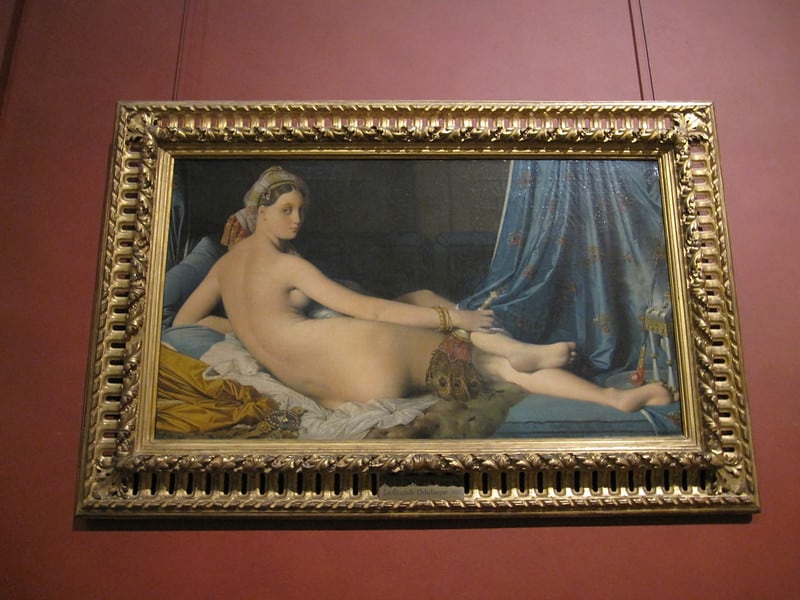
The painting depicts an odalisque, a term for a chambermaid who lived alongside the wives and concubines of an Ottoman sultan.
For this work, Ingres was inspired by the Dresden Venus by Giorgione and Titian's Venus of Urbino, but he added his flair and style.
For instance, he extended the woman’s proportions to make it less tied to anatomical realism.
Instantly recognizable, this painting shows us Ingres’ movement from Neoclassicism towards the more exotic Romanticism that would define his later career.
Ingres’ creativity would inspire the Impressionists and modernists, such as Picasso and Matisse.
4. The Raft of the Medusa
Théodore Géricault – 1819
Denon Wing, 1st floor, Room 702
Honestly, if you only see one painting in the Louvre, I think it should be The Raft of the Medusa by Théodore Géricault.
He details the devastating aftermath of a shipwreck on July 2nd, 1816.
The crew was shipwrecked off the coast of what is now Mauritania in Northwest Africa.
One hundred forty-seven men had been aboard the Medusa, and they quickly constructed a raft.
However, within 13 days, all but 15 of the men would die.
They suffered from extreme dehydration and had only survived murder and cannibalism.
This painting depicts the horrific moment when a French military ship passed by the raft but neglected to save the men.
This moment, as well as the incompetence of the Medusa’s captain, became an international scandal.
Géricault interviewed two survivors of the horror and even asked them to re-enact their traumatic experiences.
The result is chilling but also compelling and realistic.
5. Death of The Virgin
Caravaggio - 1601-06
Denon Wing, Room 710
Caravaggio was violent, rude, and homicidal – and highly talented.
He was a controversy magnet, demonstrated when his patron refused this painting for vulgarity.
Despite Caravaggio’s toxic personal life, no one can deny his spectacular talents.
He depicted everyone – saints and sinners alike – as rawly human and realistic.
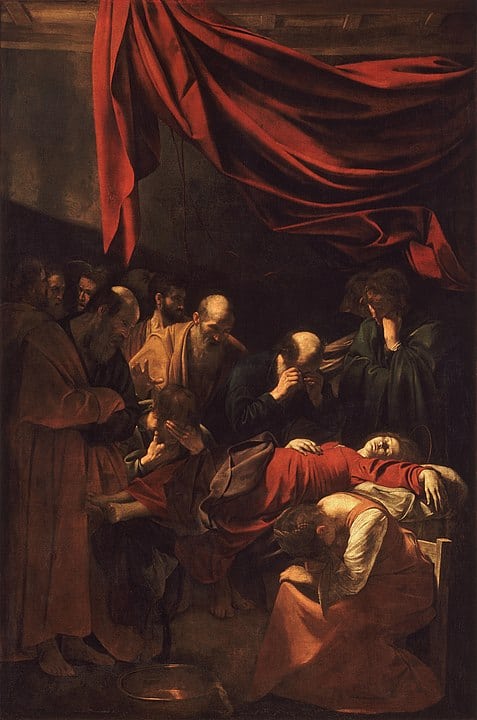
He was known for using beggars and prostitutes as models, and that likely upset this patron – a Vatican lawyer.
After all, the scene is meant to show us the pious heavenly ascent of the Virgin Mary.
Instead of the flawless blonde woman rising to the heavens, we see an ordinary woman lying in a dark room.
In a demonstration of chiaroscuro (a contrast of light and dark), she is lit by an unknown source.
Though she is a divine figure (as demonstrated by her pale halo), she is lifeless and undignified – Caravaggio wants us to know that we are all equal in death.
She wears red rather than her typical blue, surrounded by mourning apostles with expressions of grief.
The artist shows us a pivotal moment in Christianity made as mundane as possible so we can all relate.
6. Bathsheba At Her Bath
Rembrandt - 1654
The legendary Rembrandt is well represented at the Louvre, but this is the most remarkable painting.
It depicts an Old Testament story wherein Bathsheba bathes, and an attendant dries her foot.
This scene, which usually includes a young King David, is the subject of the much-covered song Hallelujah.
In the biblical story, 2 Samuel 11, King David sees Bathsheba emerging from her bath and is instantly captivated by her.
They have intercourse, and she becomes pregnant.
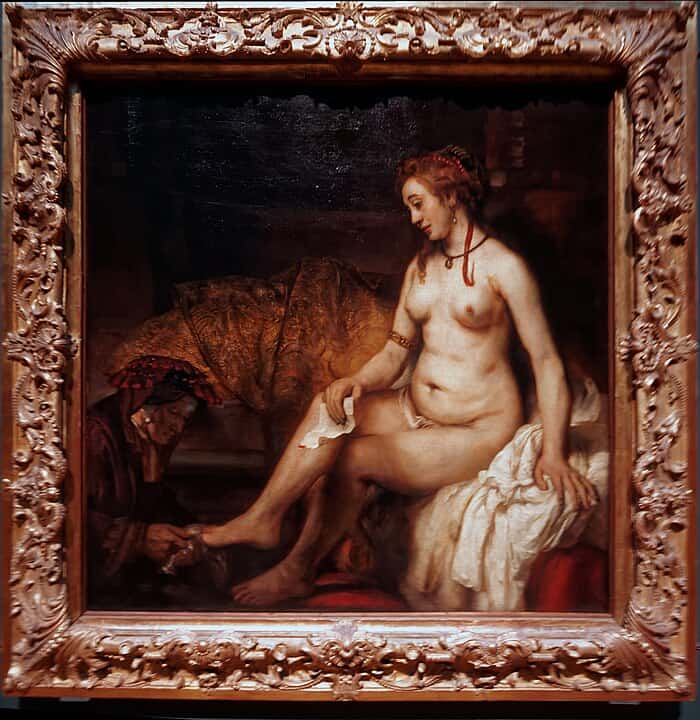
To marry her and conceal his adultery, David sends Bathsheba’s husband Uriah the Hittite, into battle, and his generals are ordered to abandon him, guaranteeing his death.
Most painters choose to depict David first seeing Bathsheba, but Rembrandt instead shows us Bathsheba making her harrowing choice.
She is depicted as a natural woman rather than a mythical representation.
Rembrandt is a master of light and shadow, never more apparent than in this arresting work.
7. The Coronation of Napoleon
Jacques-Louis David - 1807
Denon Wing, 1st floor, Room 702
Our next massive painting shows us the coronation of Napoleon, which occurred in Notre Dame Cathedral.
Napoleon had led several victorious military campaigns in Egypt and Italy and was crowned leader of the French Empire on December 2nd, 1804.
He managed to persuade Pope Pius VII, who rarely traveled, to come to Paris from Rome and give him his blessing!
Napoleon was all about trying to evoke the previous grandeur of Charlemagne’s coronation 1000 years earlier.
Painter Jacques-Louis David did not have a ton of artistic leeway.
Napoleon was a stickler about the details of this painting, and he dictated precisely who should be in it and where they should be situated.
Therefore, this isn’t exactly an accurate depiction of the event but an idealized version of what Napoleon wanted to have happened.
For instance, though his mother, Letizia Bonaparte, is depicted prominently, she was against the coronation and did not attend!
His brother, who also did not attend, is also in the painting.
On the day, Napoleon grabbed the crown from the Pope and placed it on his own head, which was considered quite rude, to say the least.
This removed the symbolic approval that God was placing the crown on his head, humiliating the Pope.
Afterward, he probably realized that this moment had not painted him, no pun intended, in the best light.
So, he has David portray him placing the crown on Empress Josephine’s head, a much more courteous and gracious gesture.
The painting was a huge success, and Napoleon loved it.
He said, “It is not a painting. There are people walking in this picture. Life is everywhere. David, I salute you. You have made me a French knight.”
8. The Lacemaker
Johannes Vermeer – 1669
Room 837, Richelieu Wing, 2nd floor
The mysterious Johannes Vermeer lived a short life, leaving behind only 34 (or 37) paintings of remarkable quality and distinct style.
He was almost forgotten completely, having been rediscovered in the mid-19th century.
Vermeer is known for his meticulous depictions of young women, likely modeled by his wife and daughters.
This is the smallest and most abstract of all his works, painted in 1670, around the same time (and cut from the same bolt of canvas) as A Young Woman Seated at the Virginal.
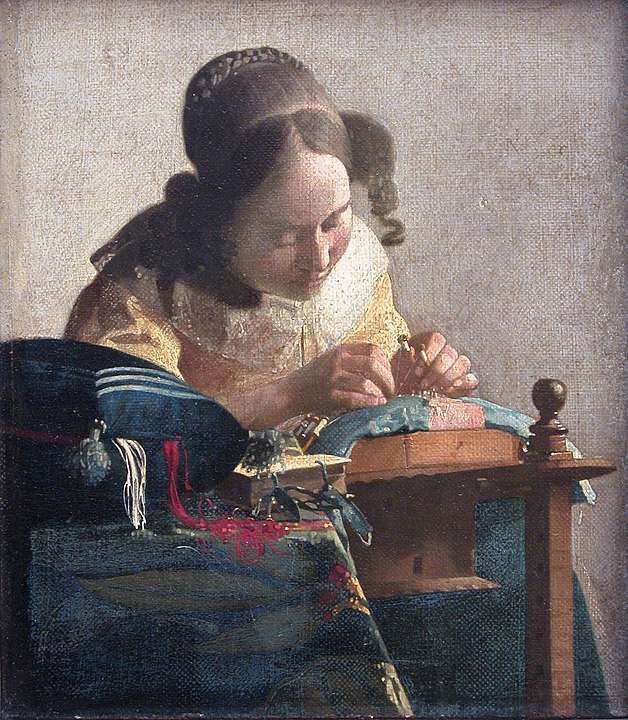
In this painting, a young woman leans over a piece of lacework, hard at work on a painstaking task.
The subject is slightly out of focus, leading some experts to believe that Vermeer may have used a camera obscura to project the image onto the canvas.
However, this may have been done on purpose to suggest depth of field, which was highly unusual at this point in art history.
Tragically, Vermeer would die just a few years later, leaving his wife and 11 children in abject poverty.
Today, at the Louvre, we can give him all the credit he deserved in his lifetime.
9. The Wedding Feast at Cana
Veronese – 1563
Salle des États - Denon Wing
Okay, once you’ve seen the Mona Lisa, do something that most people do not– turn around.
That’s right – if you swivel just 180 degrees, you’ll see a monumental canvas of epic proportions depicting the biblical tale of Jesus turning water into wine.
It’s the largest painting in the Louvre!

This is one of Paolo Veronese’s most accomplished works and is considered a marvel of the High Renaissance and Mannerist styles.
Veronese combines the biblical scene with Greek and Roman architecture, as well as contemporary Renaissance touches.
The figures in the painting are a who’s who of European and Ottoman dignitaries, including statemen and royals.
Veronese includes himself and his fellow Venetian painters in the painting as well – he’s the musician in a white tunic, while Tintoretto, Titian, and Bassano all play instruments.
Stand here and take in all the details – you’ll be amazed.
10. The Pastoral Concert
Titian - 1509
Denon Wing, Room 711
The Pastoral Concert is a legendary painting that has inspired every generation of painters since and is most notable as the inspiration for Manet’s 1863 Le Dejeuner sur l’Herbe.
It is all about fantasy and storytelling at a time in history when most of the population could not read – viewing a painting like this would be like going to the movies.
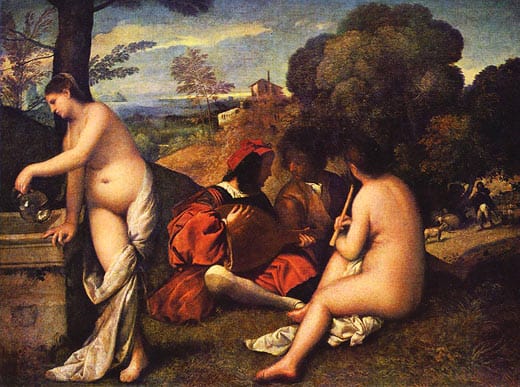
Titian was a true master of creating richly colored fantasy scapes.
His talent for depicting Greco-Roman myths, biblical stories, and whimsical portraits made him a key figure in the Venetian Renaissance.
In this work, the two nude women dancing in the foreground of the painting are the musicians’ magical vision.
With their robes and nudity, they represent ideal beauty and poetry.
The men are so caught up in the blissful music that their fantasies have manifested in front of them.
It’s a beautiful scene and one of the most famous paintings at the Louvre.
11. The Médici Room
Peter Paul Rubens – 1622-25, Room 801 (Galerie Médicis), Richelieu wing, Level 2
The Galerie Médicis is filled with monumental paintings commissioned by Marie de Medici from the legendary painter (and shrewd political operative) Peter Paul Rubens.
This room in the Louvre was specially designed for these canvases, which were initially displayed in two rooms in the Luxembourg Palace.
In this series, Rubens depicts pivotal episodes of the queen’s life, told chronologically, and carefully skirted her many controversial episodes.
King Henri IV's widow and King Louis XIII's mother hailed from Florence's wealthy Medici banking family.
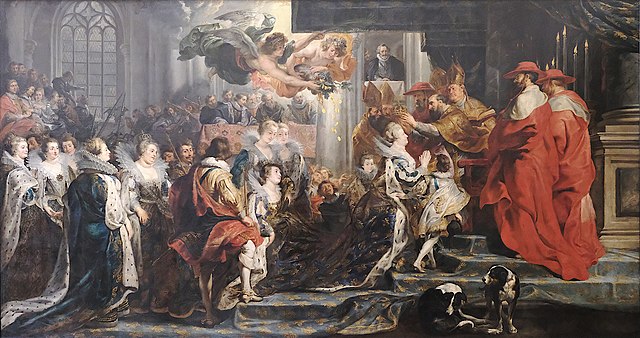
In 1622, when Marie de Medici returned from an exile imposed upon her by her son, Rubens was a hugely sought-after painter. Of course, Marie only wanted the best.
He agreed to a breakneck deadline for the massive project – just four years – and completed it in time.
They were delivered just in time for the wedding celebration for Marie’s daughter, Henriette, and Charles I of England.
The collection includes 21 canvases, every 4 meters in height, which stacks up to an impressive 300m2 of paintings.
That’s a lot to admire!
12. St. Francis Of Assisi Receiving Stigmata
Giotto di Bondone 1295 – 1300, Denon Wing, Room 708
Let’s start with a Byzantine painting and the oldest we’ll cover today.
“Byzantine” means that it is a Greek Christian painting hailing from the former Eastern Roman Empire between the fourth and the fifteenth century.
It typically features static figures with no perspective or depth and a lot of gold leaf.
The style is very recognizable and very opulent!
I’ve chosen this painting, which dates to the last century of the Byzantine style because it is a great example of this style of art and its progression towards the Renaissance.
Compared to other Byzantine paintings, Giotto’s work features more emotion and interaction between the figures.
The work depicts a flying Christ, depicted as a seraphim, delivering stigmata to St. Francis on Mount Alverno.
Christ’s own wounds are rays of light that pierce Francis' body, which is an inventive touch.
While Giotto’s flat background mountains are typical of Byzantine art, there is an attempt to add perspective in the facial features and chiaroscuro (a sharp contrast of light and dark).
This legendary work became a part of the Louvre’s collection during Napoleon’s era of looting art from Italy.
Say what you want about him – he had good taste!
8 Must-See Art Pieces in the Louvre
As one of the world’s most famous museums, The Louvre is a bucket list destination for visitors to Paris.
Part art gallery and part archaeology museum, the Louvre is an awe-inspiring place.
But spread across 400 rooms and three massive wings, it can be overwhelming! It can also be tiring, so make sure you wear comfortable shoes.
The Louvre has countless beautiful objects, but not everyone has three days to explore.
When you’re on a tighter timeline, here are the must-see objects and paintings in the Louvre that everyone should visit.
Remember – the Louvre is massive and can be confusing to navigate. Also, the lines to get in without a pre-booked slot are really long!
Therefore, I recommend that you book a guided tour with skip-the-line access.
Trust me – it makes your experience a lot smoother and really removes the stress. Check out the best guided tours of the Louvre, which all include the entry fee.
1. IM Pei’s Pyramid
We have to start our tour from the outside in – with the Glass Pyramid added to the Louvre in 1984.
Designed by Chinese-American architect IM Pei, it instantly became a ‘love it or hate it’ addition to the museum.
This modernist steel and glass pyramid is a brilliant juxtaposition with the older buildings and the palace around it.
Yet, to this day, it's one of the world's most divisive pieces of architecture.
Of course, Pei did not just design the Pyramid, which is equally beautiful when viewed from inside the museum.
He also designed a complex underground complex and new entrances so that the Louvre could enter the 21st century and better accommodate millions of visitors each year.
Love it or hate it, it’s our introduction to the museum and well worth a good look.
2. The Great Sphinx of Tanis
Location: Entrance to the Department of Egyptian Antiquities
Now that we’re inside, let’s start with the object often called the “guardian of the Louvre Museum.” This is one of the largest sphinxes outside of Egypt!
It was discovered in 1825 in the Temple of Amun in Tanis, which was the Egyptian capital during the 21st and 23rd Dynasties.
Be sure to notice its outstretched claws – though its face looks serene, this is no resting kitty.
It can be difficult to date because different Pharaohs scratched out their predecessors’ names and replaced them with their own! Very cheeky.
Therefore, Egyptologists can only date it between the 4th (2613 to 2494 BC) to the 12th Dynasty (1991BC- 1783BC).
The Louvre acquired this statue through the estate of Henry Salt – and he purchased it from Egypt on the advice of Jean-Francois Champollion.
Who is he? The translator of the Rosetta Stone, the first head of the Louvre’s Egyptian Department, and the reason we can understand these hieroglyphics.
3. The Louvre’s Mummy
While the Louvre has a large collection of mummy coffins and sarcophagi, it only has one actual mummy, and curious visitors always surround him. He really is the highlight of the
Louvre’s Department of Egyptian Antiquities’ 50,000+ pieces. The collection spans more than four millennia, from 4,000 BCE to the 4th century CE.
Of course, if you’re like me, you’ll be drawn to the mummy.
It is unlike any other on display in the world, with an intricate head wrapping.
The face and skull are encased in woven strips of linen, creating a geometric twisted square pattern.
The Louvre has X-rayed him and found that he probably lived between 305 BC to 30 BC, which was the Ptolemaic Period of Ancient Egypt.
He may have been named Nenu or Pachery.
He was almost certainly upper-middle-class, as this form of mummification was only for the elite.
Most of his abdominal organs were preserved in jars, and his brain and heart were kept intact in his body.
He was dried out with salt and then covered with resin and aromatic oils before being wrapped, and he survives now, more than 2,000 years later.
4. The Code of Hammurabi
Location: The Richelieu Wing, Room 227
Heading to a completely different part of the museum, let’s go and have a look at a piece of legalese dating to 1754 BCE.
The Code of Hammurabi is a well-preserved code of law from ancient Mesopotamia.
It was enacted by King Hammurabi, the sixth King of Babylon, who ruled from 1792 to 1750 BCE, making this even older than the biblical laws of Christianity.
The impressive stone stele is 2.5 meters tall (7.5 feet) and chronicles 280 laws covering the most common problems someone in Ancient Babylon would face.
At the top of the stele, you can see the God Shamash – he is gifting this ‘divine’ code directly to King Hammurabi.
The Code of Hammurabi was discovered in 1901 and was soon translated from its original Akkadian language, using cuneiform script.
The first two sections praise Hammurabi and call him the protector of the “weak and oppressed,” while the third section details the actual laws.
Some of the laws are about nurses’ duties, marriage, divorce, adoption, inheritance, and engagement.
If you or a loved one are in a legal profession, this is a highlight of the Louvre.
5. The Lamassu
Location: The Richelieu Wing, Room 229
Let’s stay in the Richelieu Wing to see another impressive collection of sculptures – a number of Lamassu.
These protective spirits and guards stood sentry at palace and city entrances in ancient Assyria.
You can find them in the British Museum and the Metropolitan Museum of Art, but I think they’re most impressive at the Louvre.
They have recreated a landscape so we can see what they would have looked like in Khorsabad, in what is today Northern Iraq.
The Lamassu, which is Akkadian for ‘protector,’ guarded the Palace of King Sargon II, who ruled from 721 – 705 BCE, and they have five legs each.
This is so they could ‘kick’ away evil and make them look active and 3D. They tower over you at 4 meters (12 feet) tall!
These are both art and artifacts – do not miss them.
6. Michelangelo’s Dying Slave and Rebellious Slave
Location: Italian Sculpture Hall, Ground Floor Denon Wing
We’re heading towards some of the most famous objects in the Louvre now.
Of course, when the doors open in the morning, everyone runs towards the Mona Lisa, but I recommend giving these remarkable statues your full attention.
The sculptures were created by one of the most iconic Renaissance artists, Michelangelo, between 1513 and 1516.
Along with four others, they flanked the tomb of Pope Julius II before the Louvre purchased them in 1794.
They are every bit as fascinating and complex as Michelangelo’s David (which is in Florence), depicting agony, ecstasy, life, and death.
The artist and genius had just finished the Sistine Chapel ceilings – he was truly on a roll.
These are my favorite objects in the Louvre – don’t miss them.
7. The Venus De Milo
Sully Wing, Floor 1, Room 346
Now, here is an object that you truly cannot miss – The Venus de Milo, one of the world’s most famous sculptures.
This armless beauty was unearthed on the Greek island of Melos in 1820 and likely dates to 100 BCE.
Upon her discovery by a farmer in his field, she was immediately referred to as “Venus,” as Roman mythology was very popular at the time.
However, there’s a significant error with this name. Venus is a Roman goddess of sex and love, not a Greek goddess!
This would be much more likely to be Aphrodite de Milo, not Venus.
But wait – she’s probably not even Aphrodite. She is much more likely to be Amphitrite, a goddess beloved in Melos.
It could have been sculpted by Praxiteles, but it’s equally likely to be by Alexandros of Antioch.
There is speculation that she would have been holding an apple and would have been draped in elaborate metal jewelry.
She was originally painted in bright colors.
We’re extremely lucky that 19th-century sculptors didn’t try to replace her arms, as they did with many other damaged sculptures.
I think her imperfection is what makes her so special.
8. The Winged Victory of Samothrace
Location: Denon Wing, Room 703 (Daru Staircase)
We’ve saved one of the best pieces for last, in my opinion, with the Winged Victory of Samothrace.
You’ll find it as the focal point of the massive Daru Staircase, where it has resided since 1866, and the cavernous space adds to its presence and energy.
It’s considered the finest example of Hellenistic art and will take your breath away.
The sculpture depicts Nike, the ancient Greek goddess of victory, and dates to around the 2nd century BCE.
The sculpture consists of two parts, which together rise more than 6 meters (18 feet) tall.
On her own, Nike is 3 meters (9 feet) tall! She is atop a ship’s bow, which is made from grey marble, though she is white marble.
She has dramatic wings, and the wind blows her draped clothing, pressing it into her body.
This is incredibly difficult to sculpt! We can see the outline of her very feminine form beneath the folds of her clothing.
When you come to see this statue, make sure you move around and try to see it from many different angles.
Like the Mona Lisa, it really is a different experience every time you move, even slightly.
Unlike the Venus de Milo, this statue has been partially restored – the right wing is a modern replica.
Thankfully, her head, feet, and arms have not been recreated. If you want to have a look at her original hand, you can see it in a glass case to the left of the statue, in an alcove.
It was only discovered in 1950!
Visiting the Louvre
There you have it – just 20 of the must-see objects at the Louvre.
Of course, seeing all of these can be overwhelming on your own. It’s much better to book a ‘skip the line’ tour and get ahead of the crowds.
See the museum with an expert and get the most out of your visit. Check out the best Louvre tours to find your perfect guide.











